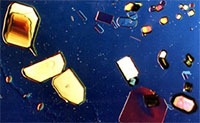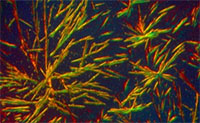Also called MLF or "malo", this is a process in winemaking where the harsh tasting malic acid, which is naturally present in grape must, is converted into softer tasting lactic acid, and the by-product CO2.
Grapes grown in cooler regions are often quite high in acidity, much of which comes from the malic acid itself. It is generally thought that MLF can enhance the body and flavor persistence of wine, producing wines of greater palate softness and roundness.
1 g malic acid converts to approx. 0.67 g lactic acid + 0.33 g CO2
Malolactic Fermentation
(COOH-CHOH-CH2-COOH => COOH-CHOH-CH3 + CO2)
Why do it?
To reduce the acid organically in red wines and a few selected white wines. By having a wine go through a malolactic fermentation tends to create a fuller and rounder mouth feel, which tends to enhance the body, flavor and overall character of the wine.
If a wine is high in malic acid it is therefore naturally more acidic, so a greater reduction would be achieved through MLF making it a much smoother and rounder wine. Converting the 'green apples' taste of malic acid into the softer, milky-like lactic acid which is richer and more buttery tasting is often what is desired. In cool climate winegrowing areas, the grapes are frequently higher in acidity - much of which comes from malic acid. Some color can be lost, but this is unlikely to be of concern in red wine MLF.
When to use it or not
Red wine destined for aging in barrel are primary candidates, as the MLF can happen when the wine is in the barrel and so is able to pick up all the soft, buttery characteristics of the oak. It is a gentle and silent fermentation, unlike the primary ferment where movement can always be seen in the air lock as the CO2 escapes.
White wines such as Chardonnay, Pinot Gris and Pinot Blanc can often also benefit, however, those whites noted for their youthful, more acidic characteristics, like Riesling and Gewurtztraminer should not undergo MLF. It is important not to affect the structure or integrity of the wine.
Effects of MLF
- De-acidification
- Bacterial stability
- Flavor changes
Factors Affecting MLF
- pH
- SO2
- Nutrient composition
- Oxygen
- CO2
- Alcohol
- Temperature
- Organic acids
- Phenolic compounds
- Presence of other lactic acid bacteria
Conditions for MLF
Requirements for proceeding with MLF are:
- The ideal pH needs to be around 4.0, so normally the pH for reds should be above 3.3, and whites 3.4, however, there are strains of malo bacteria that will work below these levels.
- Temperatures should be above 20-30°C. Therefore, the ideal time to inoculate the must with the malolactic bacteria is when the wine is about one third the way through the yeast fermentation, and hasn't yet begun to drop in temperature.
- Inoculate during the latter stages of fermentation while nutrient levels in the must are higher.
- Low SO2 levels, between 10-20 ppm are also necessary, (this is normally the amount added at pre-crushing).
- MLF is completed within two months so long as the wine is kept at a fairly warm temperature - above 20°C.
- No SO2 additions are necessary until either the reds are pressed or the whites are racked.
- Once you feel that MLF is finished, you can stabilize your wine by adding sulfites at the rate of approx. 50 ppm.
Process of MLF
 Malic acid under the microscope, with its large angular conformation
Malic acid under the microscope, with its large angular conformation
 Lactic acid reveals a smaller molecular display under the microscope
Lactic acid reveals a smaller molecular display under the microscope
By kind permission of Sondra Barratt PhD
sondrabarrett.com
A malolactic conversion is undertaken by lactic acid bacteria (Oenococcus oeni), which eat up the malic acid creating energy. This conversion can happen naturally depending on the conditions - for both wine and temperature, but most winemakers prefer to control MLF by inoculating the wine with a desirable bacteria. The reason for this, is that undesirable strains of bacteria can produce off flavors and could spoil the wine. On the other hand, when a higher acidity level in a wine is required, commercial winemakers are able to prevent a malolactic conversion from taking place at all.
What happens chemically.
In a malolactic fermentation, carbon dioxide is liberated as malic acid, (already present when the grapes are crushed), and is consumed. A malo conversion can happen at any time during or after the primary fermentation. Unlike the initial fermentation, when the exodus of CO2 is easily seen in the airlock; with MLF there are few signs of anything happening at all, except for a very quite murmur from within the barrel or other vessel. A wine going through MLF will be cloudy due to bacterial presence, and might have the odd smell of buttery popcorn, due to the production of diacetyl.
Problems that can arise
Uncontrolled MLF is not at all desirable, as the same bacteria responsible for reducing acidity are also responsible for the production of sauerkraut, whose aromas and flavors do not befit a good wine.
In addition to transforming malic into lactic acid, leuconostoc oenos also transforms citric acid into acetic acid. This is the acid that gives vinegar it's notable flavor, however, this is not normally a problem, unless the must has been treated with citric acid.
Wines made from concentrate are generally unsuitable for MLF treatment.
N.B. ensure that the conversion occurs prior to bottling, if not, then the wine must be sterile filtered and sterile bottled, to guarantee that it won't happen in the bottle.
More useful info on Malolactic Fermentation from UC Davis.

